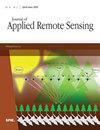MDSC-Net:遥感图像中道路提取的多向空间连通性
IF 1.4
4区 地球科学
Q4 ENVIRONMENTAL SCIENCES
引用次数: 0
摘要
从复杂的遥感图像中提取道路是自动驾驶、路径规划和道路导航等应用的关键任务。然而,传统的基于卷积神经网络的道路提取方法大多依赖于局部空间域的平方卷积或扩张卷积。在多方向连续道路分割中,这些方法可能会导致道路连通性差和边界不平滑。此外,无法准确预测被阴影、建筑物和植被遮挡的道路区域,这也会影响道路分割的连通性和边界的平滑度。为了解决这些问题,本研究提出了一种基于多向条带卷积的多向空间连接网络(MDSC-Net)。具体来说,我们首先设计了一个多方向空间金字塔模块,利用多尺度和多方向特征融合来捕捉邻域像素之间的连通关系,有效区分狭窄和尺度不同的道路,提高道路的拓扑连通性。其次,我们构建了边缘残差连接模块,以持续学习并将道路边界和浅层特征图的详细信息整合到深层特征图中,这对道路边界的平滑性至关重要。此外,我们还设计了一种高低阈值连接算法,用于提取被阴影、建筑物和植被遮挡的道路像素,进一步完善纹理和道路细节。在两个不同的公共基准(DeepGlobe 和渥太华数据集)上进行的广泛实验表明,MDSC-Net 在提取道路连通性和边界平滑度方面优于最先进的方法。源代码将在 https://github/LYY199873/MDSC-Net 公开。本文章由计算机程序翻译,如有差异,请以英文原文为准。
MDSC-Net: multi-directional spatial connectivity for road extraction in remote sensing images
Extracting roads from complex remote sensing images is a crucial task for applications, such as autonomous driving, path planning, and road navigation. However, conventional convolutional neural network-based road extraction methods mostly rely on square convolutions or dilated convolutions in the local spatial domain. In multi-directional continuous road segmentation, these approaches can lead to poor road connectivity and non-smooth boundaries. Additionally, road areas occluded by shadows, buildings, and vegetation cannot be accurately predicted, which can also affect the connectivity of road segmentation and the smoothness of boundaries. To address these issues, this work proposes a multi-directional spatial connectivity network (MDSC-Net) based on multi-directional strip convolutions. Specifically, we first design a multi-directional spatial pyramid module that utilizes a multi-scale and multi-directional feature fusion to capture the connectivity relationships between neighborhood pixels, effectively distinguishing narrow and scale different roads, and improving the topological connectivity of the roads. Second, we construct an edge residual connection module to continuously learn and integrate the road boundaries and detailed information of shallow feature maps into deep feature maps, which is crucial for the smoothness of road boundaries. Additionally, we devise a high-low threshold connectivity algorithm to extract road pixels obscured by shadows, buildings, and vegetation, further refining textures and road details. Extensive experiments on two distinct public benchmarks, DeepGlobe and Ottawa datasets, demonstrate that MDSC-Net outperforms state-of-the-art methods in extracting road connectivity and boundary smoothness. The source code will be made publicly available at https://github/LYY199873/MDSC-Net.
求助全文
通过发布文献求助,成功后即可免费获取论文全文。
去求助
来源期刊

Journal of Applied Remote Sensing
环境科学-成像科学与照相技术
CiteScore
3.40
自引率
11.80%
发文量
194
审稿时长
3 months
期刊介绍:
The Journal of Applied Remote Sensing is a peer-reviewed journal that optimizes the communication of concepts, information, and progress among the remote sensing community.
 求助内容:
求助内容: 应助结果提醒方式:
应助结果提醒方式:


